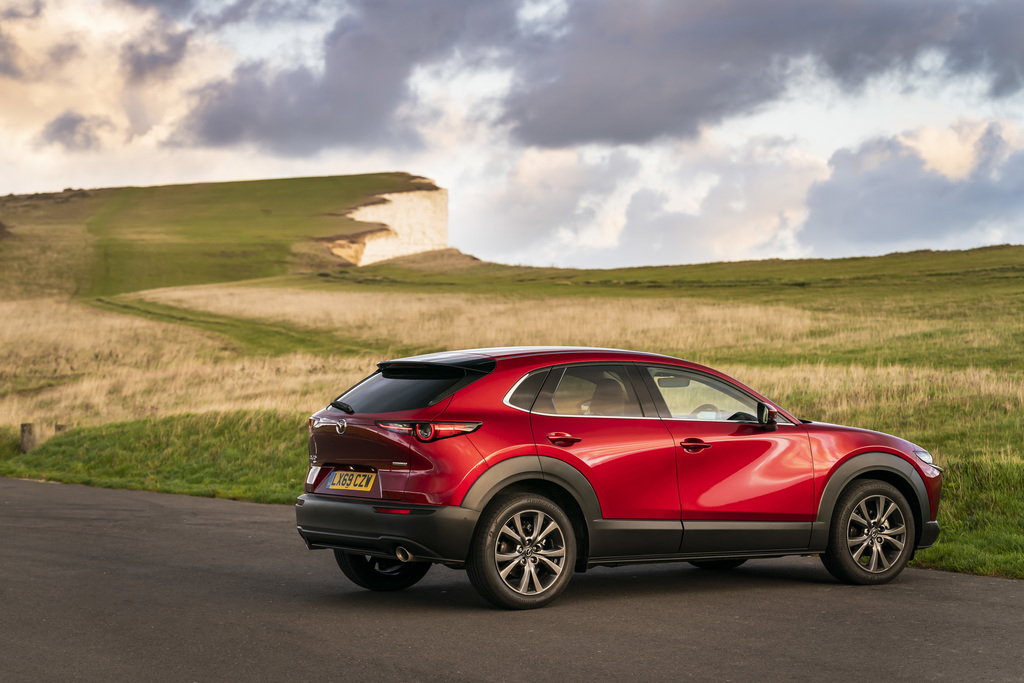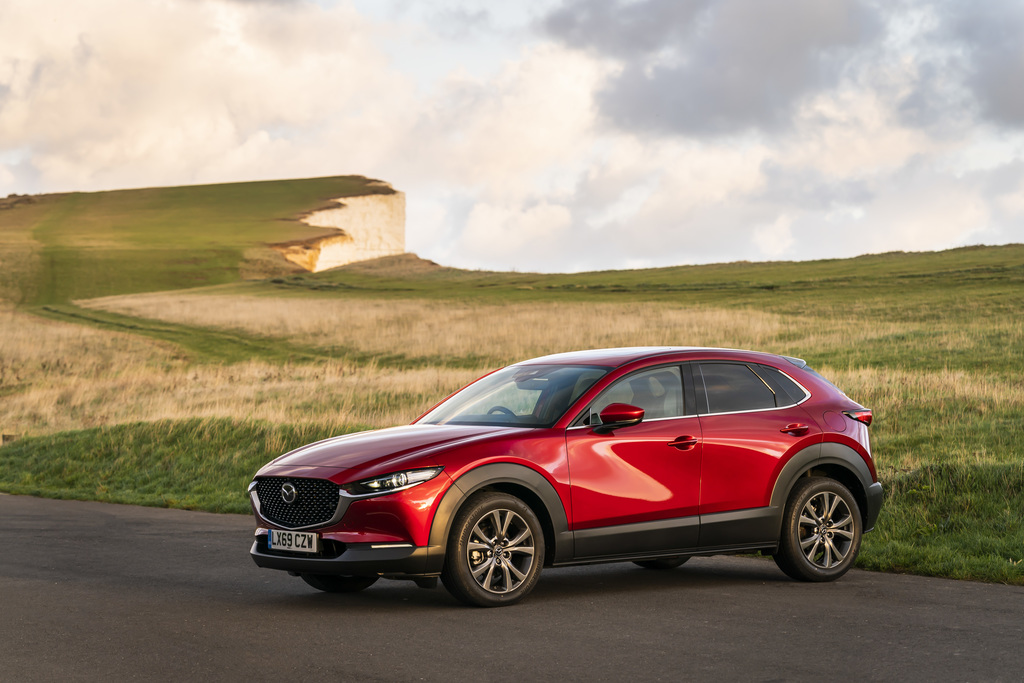 Kieron Fennelly puts the CX 30 through its paces – and describes its clever, innovative SkyActiv engine…
Kieron Fennelly puts the CX 30 through its paces – and describes its clever, innovative SkyActiv engine…
Mazda is one of the smaller manufacturers, rather like Volvo. However, unlike the Swedish company which is part of the Chinese concern Geely, Mazda continues to plough an independent furrow. For many years, Ford was a major shareholder, but Dearborn gave up its 33% in 2010 when it also sold off Aston Martin, Jaguar and Volvo. Since then Mazda has quietly consolidated its position and in the last year it was one of only a handful of car manufacturers to increase sales in the British Isles. The company has been helped by its strong following and designs which are hardly revolutionary but nonetheless manage to differ subtly from the mainstream. This is combined with a reputation for engineering quality. For thirty years Mazda has also made the acclaimed MX 5, a traditional sports car in the MG or Triumph TR mould.
The new CX 30 is a typical Mazda, conventional yet discreetly stylish, but it harbours under the bonnet a remarkably innovative petrol engine. The CX 30 is based on the company’s medium size hatchback Mazda 3 and is designed to appeal to buyers seeking the high-riding spaciousness of an SUV with the looks and handling of a hatchback. This type, known as ‘crossover’, has now built a huge marketplace and all the mass manufacturers are participants – from Nissan and Renault with, respectively, the Qashqai and Captur, to BMW and Audi with their X2 and Q2 offerings.
Mazda’s representatives claim the new model combines ‘clean design’ with ‘visual dynamic poise, striking a balance between shadow and light’ and while such descriptions may sound rather high flown, they have a point: visually the car is pleasing and, relatively bereft of chrome embellishments, it has none of the garishness of certain competitors, its lines flowing largely uninterrupted and avoiding the visual voluminousness of SUVs. Its black sills and nicely flush wheel arches successfully blur any impression on the other hand that this is merely the hatchback on stilts: Although the CX 30 does share the underpinnings of the hatchback Mazda 3, it is both longer and has a greater wheelbase.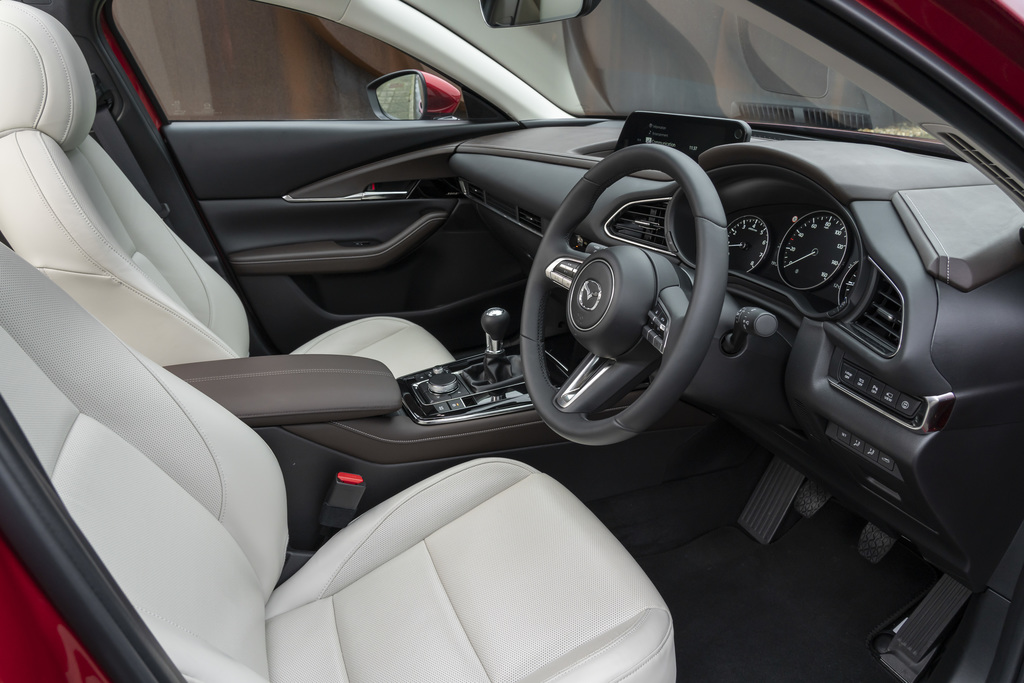
The interior is well finished: Soft touch plastics predominate on fascia and door furniture and harder cheaper surfaces are limited to areas outside the normal visual field. The front seats themselves are well-shaped, the driver’s has three-way adjustment and a comfortable driving position is easy to find. Although entirely digital, the dashboard is dominated by traditional-look round speedometer and rev counter, and a large knob beside the gearshift controls the multi-function information screen. It is a conservative layout which will please drivers put off by the excessively ‘technical’ control panels some manufacturers now seem compelled to offer. Pleasant enough, the CX 30’s cabin is by no means large and the rear seat will feel cramped for taller adults. Boot space at 430 litres (15.19 cu.ft) is average and essentially the crossover does not provide much more space that its hatchback sibling.
The driver has excellent visibility (except for reversing, but here the camera assists manoeuvring) and the only criticism concerns the mirrors. Commendably Mazda has placed them on the door so that the A pillar does not represent the large blind spot which bedevils so many modern cars where mirror and pillar are one solid unit; on the Mazda the driver can see between them. However, people who like to sit close to the steering wheel may find they have to turn their heads rather than just their eyes to see in mirror.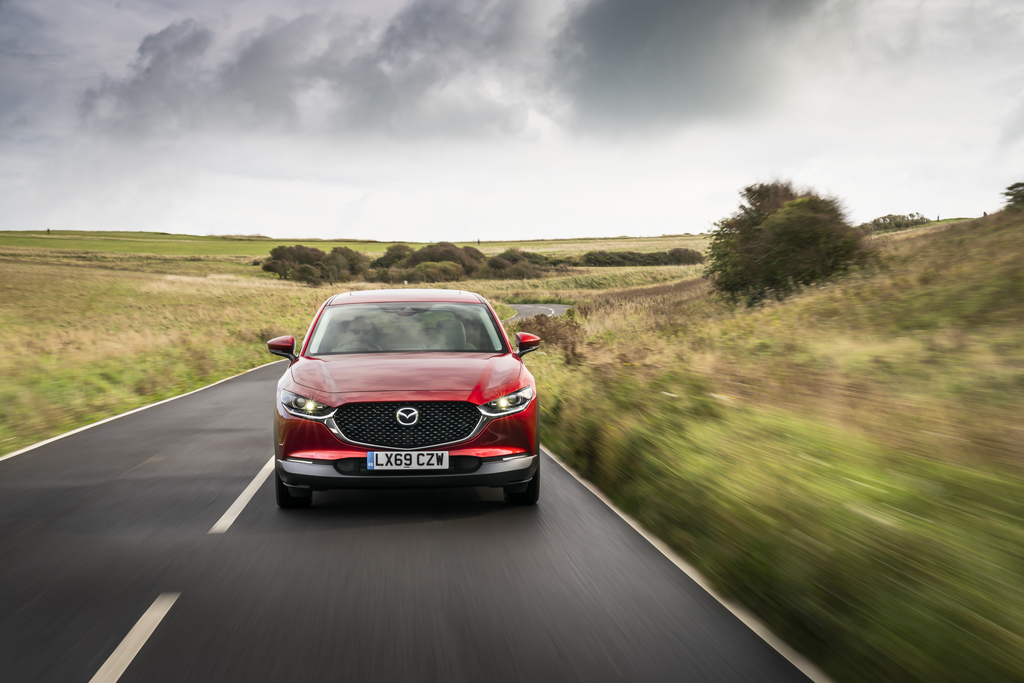
On the Move
Underway, the Mazda is impressive. The two litre ‘Skyactiv X’ engine (please see our separate information panel at the end of this feature) is smooth, the typically slick gearchange and (not too) light clutch obviously designed with the keener driver in mind are a pleasure to use and performance is brisk – Mazda claims the fastest 0–60 time in the sector. The engine is supercharged rather than turbocharged and assisted by a clever ‘mild hybrid’ system which recovers energy from deceleration and which helps performance and mpg. Drivers used to the low revs urge of diesel turbos will find the MX 30 needs to be kept in the 3–5,000 rpm range to extract the best performance, but the engine is pleasingly smooth and refined.
Around the corners despite ground clearance of 180 mm (7.09 in), half as much again over the hatchback, the CX 30 behaves like its sibling. The steering, initially light and slightly lacking in response, seems to gain both weight and reaction time as speeds increase, and the keen driver soon finds that this crossover Mazda goes around curves almost with the accuracy and alacrity of a sporty hatchback. The high seating of the crossover endows the driver with a superior view of the road. While Mazda’s chassis engineers have successfully tuned the suspension to create a comfortable and absorbent ride over poor surfaces, they have imbued a degree of body control which allows the tall Mazda to feel remarkably stable and surefooted.
VERDICT
Both good looking and pleasant to drive, the Mazda CX 30 is well-finished and equipped and makes made a convincing entrant in the crossover field. In SPCCI form, it is refined and lively with the promise of remarkable mpg.
Wheels-Alive Tech. Spec. In Brief: Mazda CX30 SkyActiv X Price: £24,375 (two wheel drive, manual transmission) Engine: Supercharged four cylinder, 1998cc, compression ratio: 16.3:1, with mild hybrid energy recovery system Max power & torque: 180 bhp @ 6,000 rpm / 224 Nm (165 lb.ft) @ 3,000 rpm Weight: 1,490 kg (3,285 lb) Performance: 0-60 mph: 8.8 sec / top speed 127 mph Combined mpg: 47.9 (5.9 litres/100km). CO2 emissions: 105 g/km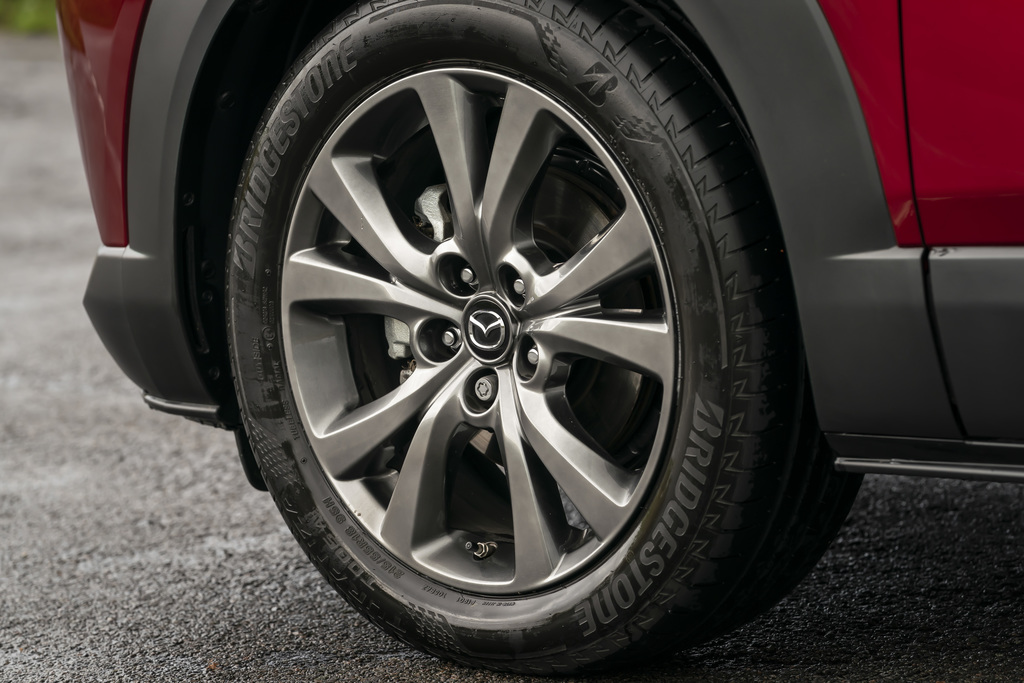
Mazda SkyActiv X ‘SPCCI’ engine information:
Essentially the SkyActiv X combines the spark-ignition of the petrol engine with the high compression-ignition of a diesel, technology that several manufacturers have investigated, but never commercialised. Mazda has now taken that step.
At its simplest, ‘SPCCI,’ spark-controlled compression-ignition uses a sparking plug to start the engine and ensure combustion when the engine is under high loads. Most of the time however, the engine functions with compression ignition. This is inherently more efficient as it allows the engine to operate with a far thinner fuel/air ratio, in the order of 37:1 rather than the 14.7:1 of petrol combustion. Not only does compression-ignition require less fuel, its combustion is spontaneous whereas ignition by spark plug takes fractionally longer. This has implications both for amounts of fuel required and exhaust emissions – Mazda claims a 30% improvement in mpg over its conventional 2 litre petrol unit and mileage comparable with diesel consumption. Arguments against diesels are their relative lack of refinement, particularly at idle and under acceleration, and of course the unresolved problem of their particulate emissions. Mazda’s SPCCI offers petrol levels of refinement yet diesel levels of economy.
As other manufacturers rush towards electric cars, Mazda points out that even in the medium term nowhere will recharging infrastructures be able to cope with a wholesale move to electric cars while questions about continued availability of the resources required to make batteries and their disposal are unanswered. Mazda believes, as do many observers, that combustion engines still have a significant role to play and impressively is putting its money where its mouth is.